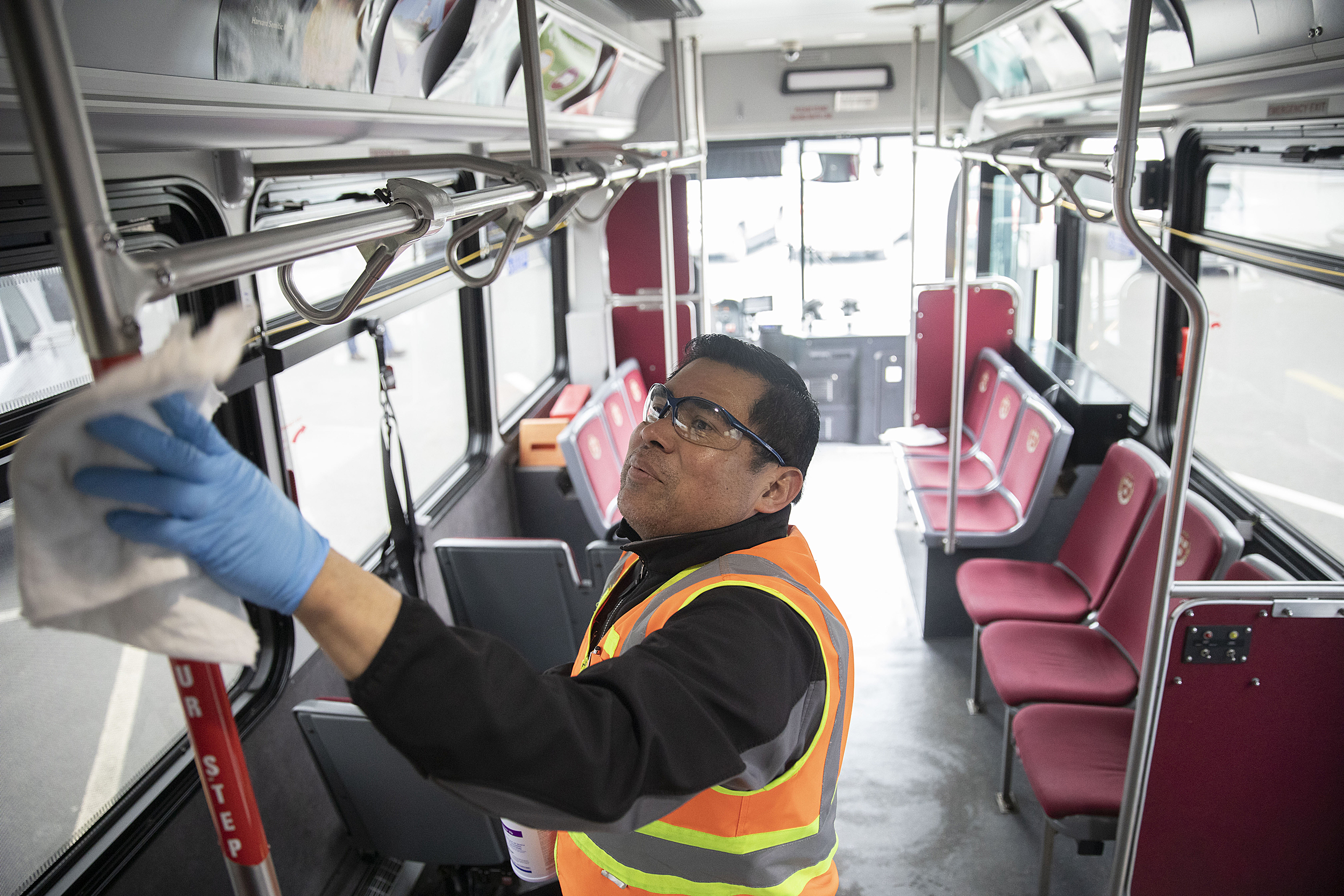
Juan Carlos sterilizes a Harvard shuttle bus. Harvard is regularly cleaning and disinfecting surfaces such as handrails and seats to reduce potential contamination for people using public transit.
Kris Snibbe/Harvard Staff Photographer
Managing the coronavirus exodus from campus
Campus Services VP Meredith Weenick on Harvard’s work to prevent the spread of disease and help students move out on a tight timeline
Think of the hustle of moving-out day, combined with the hugs and hurried good-byes of the start of spring break, with a poignancy that feels more like a school year ending — all of it unanticipated and squeezed into just a few days. This was the scene around the Yard after the University’s decision this week to ask students to return to their homes and shift to online learning for the rest of the semester in an effort to limit the spread of coronavirus in the community. At the center of all of this activity is Harvard Campus Services, which oversees the management and maintenance of facilities: dining and hospitality, engineering and utilities, transportation and parking, global support and international student services, environmental health and safety, emergency management, and the campus service center. The Gazette spoke with Vice President for Campus Services Meredith Weenick about the challenges facing her staff.
Q&A
Meredith Weenick
GAZETTE: How is Campus Services helping to ensure the health and safety of the Harvard community?
WEENICK: Campus Services is focused first and foremost on protecting the health and safety of everyone in the Harvard community. This started with our Environmental Health and Safety team, which has worked proactively over the past few weeks with the University on protocols to mitigate coronavirus. Using guidance from Massachusetts public health officials and the Centers for Disease Control and Protection, that team has developed strategies to implement those practices across campus. For example, our custodians implement the most effective cleaning techniques, and our dining hall workers are taking measures to reduce the potential spread of the virus. We’re also focused on adapting all of these strategies to critical areas as our population shifts. As President [Larry] Bacow noted in his message to the community on Tuesday, the fewer people who are on campus, the safer the environment becomes for us all. As students have begun to leave, we are able to shift our focus as needed.
“We’ve mobilized our team, and I have to say that I was particularly impressed with how quickly our employees were able to pivot.”
GAZETTE: How has Custodial Services adjusted its approach?
WEENICK: Experts have told us that one of the qualities of this virus is how easily it spreads. Using that guidance, we have implemented a strategy to maximize prevention, concentrating our cleaning efforts on common areas with a lot of high-touch surfaces, such as bathrooms, lobbies, elevators, and kitchenettes. On the shuttle buses, we’re regularly cleaning and disinfecting surfaces such as handrails and seats to reduce potential contamination for people using public transit. We have made sure that our staff has an enhanced presence in these critical areas, which you will see as you are walking around campus. Our custodial staff has truly been key to our prevention efforts. When we bring them onto the team, we train them for just this type of situation, so that has been of tremendous value. But beyond that, our custodians, and all Campus Services employees for that matter, are truly doing an outstanding job, especially given the stressful and uncertain nature of this unprecedented moment.
GAZETTE: How has your team been working to manage the student move-out that is now in progress?
WEENICK: Transitioning students out of dorms is an enormous undertaking even when it’s planned. Doing so with a condensed timeline has definitely presented a challenge, but our goal remains the same: We are laser focused on providing the support students need to make this process as easy as possible. We’ve mobilized our team, and I have to say that I was particularly impressed with how quickly our employees were able to pivot. One of the major challenges we typically face is keeping the traffic moving with all of the extra cars and moving trucks on the campus. To accommodate them, we quickly ramped up our procedures for managing parking and roadways to meet the added demand.
Something else we have to contend with is physically getting everything out of the dorms on this timeline. To handle this, our employees have been working right alongside the students over the past few days and have been lending a hand with everything, from moving furniture to taking out trash and recycling. We’ve called in a number of additional trucks to help manage the items that are left behind during a move-out.
You may have also noticed a lot of pink bags as you walk around campus. Our team has distributed thousands of them across the University, which students can fill with items they wish to donate. The items will be sold, and all of the proceeds will benefit Harvard Habitat for Humanity. In the next day or so you will see donation bins around the Houses for this very purpose.
To echo all of the other leaders on campus, this has been an enormous undertaking for each and every member of our community. We’re proud to be working so closely with such dedicated colleagues, and looking forward to continuing to support not just students, but everyone in the community in the days to come.
Interview was edited for clarity and condensed for space.
For more coverage and updates visit our websites.




